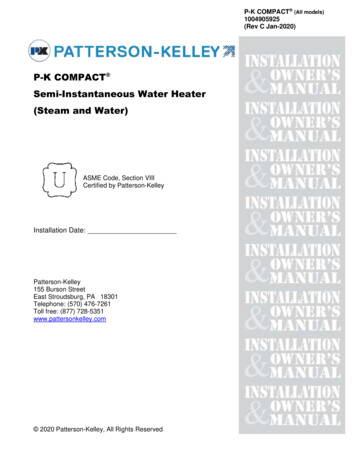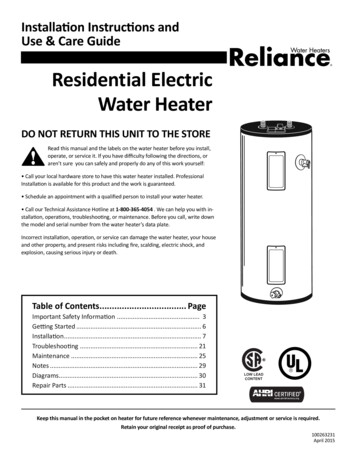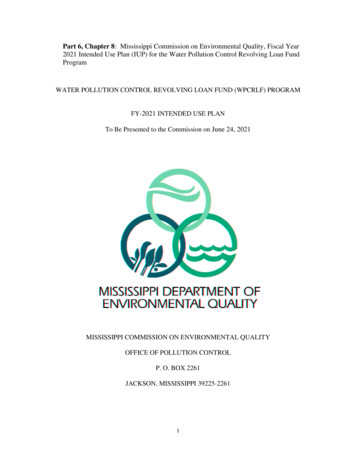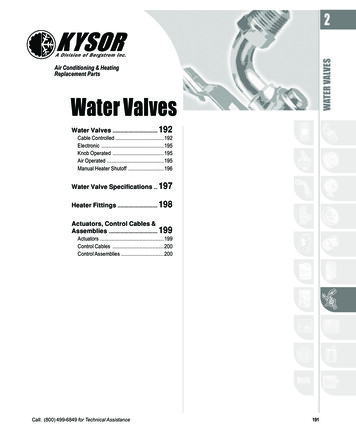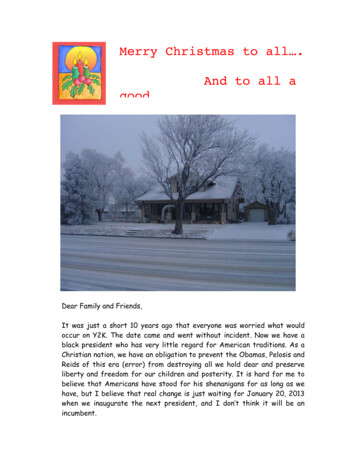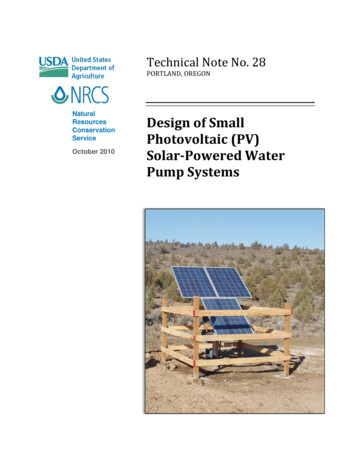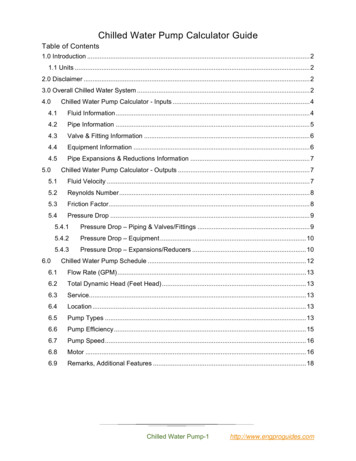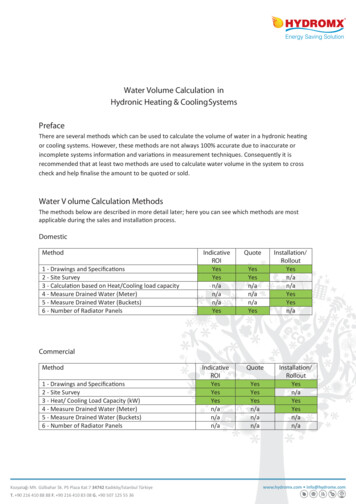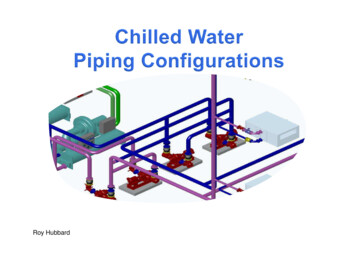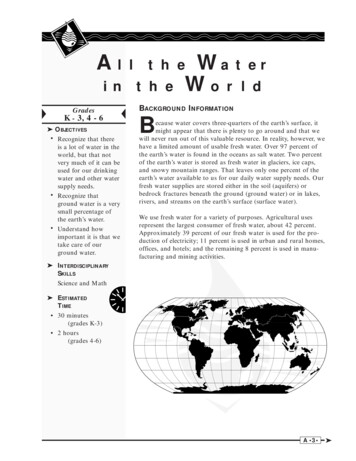
Transcription
Allin theGradesK - 3, 4 - 6 OBJECTIVES Recognize that thereis a lot of water in theworld, but that notvery much of it can beused for our drinkingwater and other watersupply needs. Recognize thatground water is a verysmall percentage ofthe earth’s water. Understand howimportant it is that wetake care of ourground water.Wa t e rWorldtheBACKGROUND INFORMATIONBecause water covers three-quarters of the earth’s surface, itmight appear that there is plenty to go around and that wewill never run out of this valuable resource. In reality, however, wehave a limited amount of usable fresh water. Over 97 percent ofthe earth’s water is found in the oceans as salt water. Two percentof the earth’s water is stored as fresh water in glaciers, ice caps,and snowy mountain ranges. That leaves only one percent of theearth’s water available to us for our daily water supply needs. Ourfresh water supplies are stored either in the soil (aquifers) orbedrock fractures beneath the ground (ground water) or in lakes,rivers, and streams on the earth’s surface (surface water).We use fresh water for a variety of purposes. Agricultural usesrepresent the largest consumer of fresh water, about 42 percent.Approximately 39 percent of our fresh water is used for the pro duction of electricity; 11 percent is used in urban and rural homes,offices, and hotels; and the remaining 8 percent is used in manu facturing and mining activities. INTERDISCIPLINARYSKILLSScience and Math ESTIMATEDTIME 30 minutes(grades K-3) 2 hours(grades 4-6)A 3
Th e C a s eof theD i s a p p e a r i n g Wa t e rGrades4-6 OBJECTIVES Demonstrate knowl edge of the conceptsof “evaporation.” Explain evaporationin the context of thewater cycle. ESTIMATEDTIME 45 minutes to readand start the experi ment 15 minutes to reachconclusions at the endof the experiment. MATERIALS Clear measuringcups Water Copies of activityhandoutsBACKGROUND INFORMATIONThe states in which water exists—solid, liquid, and gas—areoften referred to as phases. As heat is added or removed,water goes through a phase change. In its solid phase, water mole cules are structured and orderly, in its gaseous phase water mole cules lack structure and order.In nature, the energy, or heat of the sun causes water to evaporateinto its gaseous, or vapor, phase. Likewise, when we boil waterover a burner we are causing it to change from a liquid to a gas.The process by which a substance changes from a liquid to a gas iscalled evaporation.Water is continuously being heated and cooled—evaporating, con densing, freezing—depending on its environmental circumstances.As water travels its never-ending cycle between earth and sky, itencounters and mixes with a variety of substances. Some of thesesubstances are pollutants in the sense that they are harmful to liv ing things. Pollution can result both from natural sources andhuman activities.Fortunately, through the water cycle, nature provides a variety ofmechanisms for cleaning water. For example, evaporation is a nat ural water cleanser. When water evaporates, it leaves most dis solved substances and waste materials behind. Pollutants can alsobe filtered out when water moves through soil. Some pollutants set tle out in slow-moving water bodies. Nature even employs a hostof microscopic organisms to help keep water clean. Unfortunately,however, if pollutants remain in the environment, clean water caneasily become polluted all over again as it moves through its cycle.TEACHING STRATEGY1. Tell the students that they are going to be water detectives whoare being asked to solve the case of the disappearing water.2 Allow students to read the activity handouts.3. Coach students as necessary, but encourage independent think ing as much as possible.B 19
The Case of the Disappearing WaterNOTES4. Make sure students develop a hypothesis before beginning theexperiment.5. Make sure students remember to check the water level eachday.6. When the experiment is over, be sure the students record theirresults and conclusions.7. Allow the students to work in small groups.Follow-up Questions1. For what reasons might the results of each group’s experimentdiffer? Environmental variables, e.g., one group’s measuringcup may be exposed to more or less sun than the other’s.2. Suppose that during the days Mrs. Flowers was gone theweather was sunny and hot; however, when the water detec tives conducted their experiment, the weather was cloudy andcool. How would this variable affect the experiment?3. What is a variable? Something that is subject to change or vari ation; not constant.Alternate Strategy See “The Easy Evaporation Experiment” in this unit if youwish to perform this experiment without the story.B 20
Story: The Case of the Disappearing WaterThe Case of theDisappearing Waterby Susan M. McMasterThe Water Detectives Anonymous were called to the home of Mrs. Flowers.When they arrived on the scene, Mrs. Flowers’ grown son, Frank Flowers,was frantic. His mother was missing! The detectives asked Frank how long hismother had been missing.“That’s just it,” Frank said. “I’ve been traveling a lot and kept forgettingto phone her. Now I feel terrible. I have no idea where she is or how long she’sbeen missing.”“Do you know of some places where she might have gone?” asked onewater detective.Frank wrinkled his brow and thought hard. “Well,” he said, “her habitsare very predictable. If she has been gone less than a day, she probably just wentshopping. If she’s been gone for less than 3 days, she may be visiting one of hersisters. She always says ‘Guests are like fish, they start to stink in 3 days!’ Shewould never visit anyone for more than 3 days.”“If she’s been gone more than 3 days, but less than 7,” continued Frank,“she’s probably taking a vacation on a cruise ship. I’m sure she can’t afford morethan a 7-day cruise. If she’s been gone more than 7 days but less than 6 weeks,she’s probably received the grant that she applied for—she wants to study art inEurope. If she’s been gone more than 6 weeks, she is probably at her mountaincabin. However, she never stays there more than 2 months. If she’s been gonelonger than 2 months, aliens must have captured her and taken her to anothergalaxy. She loves her plants and her home. She would never stay away longer than2 months for any reason.“I think we can help you solve this mystery,” said another water detectivewho had been looking around the house.“Did you find a note?” asked Frank hopefully.“No,” said the detective, “but I did find this glass measuring cup in thewindow.”“Oh,” said Frank, “that’s nothing. Mother is very particular. Every morn ing she fills the measuring cup to exactly one cup. Then she puts it in the windowsill to warm in the sun for a little while before she waters her African Violets. Sheis very careful about how much water she uses because she doesn’t want to overwater or under-water the plants.”B 21
Story: The Case of the Disappearing Water“Aha!” said the water detective, “Just as I suspected, this is pre cisely where we must begin our search. The measuring cup now hasexactly 3/4 of a cup of water.”“Are you saying someone stole 1/4 of a cup ofwater?” asked Frank.“No wonder his mother didn’t bother to tell himwhere she was going!” muttered one of the detectives.“No, sir,” said another water detective, trying tokeep a straight face. “It’s a matter of evaporation. Ya’ see, water evaporates intothe atmosphere. The warmth of the sun changes the liquid into water vapor thatwe can’t see. After awhile the water vapor condenses and forms into clouds.Eventually, the water comes back to the ground as rain or snow or hail. Overtime, the water evaporates again. It’s part of the water cycle.”“To make a long story short,” said another detective. “We’re going to con duct an experiment. We’ll put a cup of water in a sunny place and keep track ofhow long it takes to evaporate. Based on that experiment, we will estimate howlong ago Mrs. Flowers left the measuring cup in the window sill.”“What a relief!” said Frank. “What should we do now?”“I suggest you water the plants,” replied yet another detective.B 22
Activity: The Case of the Disappearing WaterThe Case of theDisappearing WaterStep 1: Read “The Case of the Disappearing Water.”Step 2: Write down the facts of the case:1. Original amount of water in the measuring cup .2. Amount of water in the measuring cup now .Step 3: Write down where Frank Flowers said his mother might be. If Mrs. Flowers has been gone for less than a day, she probably. If she’s been gone for less than 3 days, she may be. If she’s been gone more than 3 days but less than 7, she’s probably. If she’s been gone more than 7 days but less than 6 weeks, she’s probably. If she’s been gone more than six weeks but less than two months, she is. If she’s been gone longer than two months,.Step 4: Develop a hypothesis: (Tell what you think will happen before you dothe experiment.)1. How long do you think the water was left on the window sill? .2. Where do you think Mrs. Flowers went? .B 23
Activity: The Case of the Disappearing WaterStep 5: Perform an experiment to establish approximately how long it took forthe water to evaporate.Supplies: Clear measuring cup WaterDirections:1. Write down today’s date.2. Fill a measuring cup to the 1-cup line.3. Put the cup in a sunny window.4. Record how many days it takes for the water in the measuring cup to beat the three/fourths cup line.Step 6: Write your conclusions.1. It took approximately days for the water to evaporate.2. Where should Frank begin looking for Mrs. Flowers?.Step 7: Make notes about your observations in your water detective’s notebook:.Supplementary Activities: Have students fill cups half full with water and then add other sub stances (e.g., food coloring, salt, mud). Set the cups in locations that aresunny and shady. Have students observe what happens to water insunny versus shady locations and what happens to the substances in thewater as the water evaporates.B 24
All the Water In the WorldGradesK-3 MATERIALS Globe 97 pieces ofuncooked ziti dyedblue, 1 piece dyedred, and 2 piecesdyed green or 100dixie cups (optionalstrategy) Food coloringTEACHING STRATEGYFORGRADES K-3Part A - Exploring the Globe1. Look at the globe with the students. See if they can find wherethey live on the globe. Have them point out lakes, rivers, andoceans. Explain that these are called surface waters.2. Ask the students if they know which kinds of waterbodies aresalt water and which are freshwater. Have they ever tasted saltwater? Was it good?3. Ask the students if they think there is more water or land onthe globe. Is there water beneath the surface of the ground thatwe cannot see on the globe?Part B - Demonstrating With Ziti1. Spread the ziti out on a table. Explain that there are 100 zitipieces that represents all (100%) of the water in the world.2. Using the concept of percentages, ask the students if they knowwhat the red and green zitis represent. See if they can estimatepercentages. Explain that the two green zitis represent waterthat is stored as ice in glaciers and at the poles (2%). The lone ly red ziti represents the fresh water that is available for plants,animals, and people (1% of all the water on the earth). Ask thestudents what the remaining blue zitis represent. They representthe water that’s in the ocean, 97% of all the water on earth.3. Ask the students what we should do to take good care of thewater we use in our homes and businesses. Use only what weneed.Optional StrategyUse 100 dixie cups filled with water. Use food coloring (asdescribed above) to indicate ice glaciers and fresh water.Supplementary Activities Draw a water pie. Have students draw a circle that representsall the water in the world. Have them make pie slices in thecircle that represent 97% ocean, 2% glaciers and ice, and1% fresh water. Color and label the water pie.A 4
All the Water In the World Make a water necklace. String the ziti (you’ll probably need tohave more on hand) on pieces of yarn. Have the students takethe necklaces home and explain “all the water in the world” totheir families.Grades4-6 MATERIALS Globe 5 gallons of waterTEACHING STRATEGYFORGRADES 4-6Part A - Exploring the GlobeSame as K-3Part B - Aquarium Demonstration TablespoonsAs you do this experiment, stress that the amounts represent rela tive quantities of different types of water, not actual amounts. Container (such as1. Put 5 gallons of water in an aquarium or other container. Tellaquarium) Droppers Graph paper Small containers(quart jars) Copies of activityhandoutstudents to imagine the container represents all the water in theworld.2. Have students remove 34 tablespoons of the water and putthem into a cup. Tell them this amount represents all the waterin the world that is not ocean.3. Have the students remove 26 tablespoons of water and thenanother 8 tablespoons of water from the cup containing the 34tablespoons of water. Put each into separate cups. The 26 table spoons represent the world’s ice caps and glaciers. The 8 table spoons represent the world’s fresh water. A fraction of a table spoon (1/10) represents the world’s fresh water lakes and rivers.Of that, all rivers amount to less than a drop.4. Be sure to recycle the water. Use it to water plants.Part C - Work Sheet: All the Water in the World1. Ask students to complete the activity work sheet.2. The answers to the drinking water percentages: 0.419% totaland 2.799% grand total.3. Ask students if the numbers surprised them. Did they realizethat such a small percentage of the water in the world is fresh?A 5
All the Water In the WorldNOTESPart D - Bar Graph1. Distribute graph paper.2. Ask students to create a bar graph that shows 97% ocean, 2%ice caps and glaciers, and 1% fresh water.Follow-up Questions1. Why isn’t all fresh water usable? Some is not easy to get at; itmay be frozen or trapped in unyielding soils or bedrock frac tures. Some water is too polluted to use.2. Why do we need to take care of the surface water/groundwater? Water is very important for humans, plants/crops, andanimals. If we waste water or pollute it, we may find that thereis less and less of it available for us to use.OceanIceFreshWaterAdapted from: Project Aquatic Wild. How Wet is Our Planet? Western RegionalEnvironmental Education Council, 1987.A 6
Activity: All the Water in the WorldD i d yo u k n o w. . . . ? Earth is called the water planet. Between two-thirds (2/3) and three-fourths (3/4) of the earth’s surface iscovered with water. The earth has different types of water:OceansIce caps/glaciers97.2% of total water2.38%Ground water0.397%Surface water (e.g., lakes, rivers, streams, ponds)0.022%Atmosphere0.001%Add up the percentages for water available for drinking water.Ground waterSurface waterTotalNow add ice caps/glaciersGrand TotalRemember: Only a small percentage of water is suitable for humans to drink.Not all of the water in the ground and in lakes and rivers is easy to reach or cleanenough to drink. Ice caps and glaciers are certainly hard to use for humans,plants, and animals. Some work is being done to take the salt out of ocean water(desalinate the water), but that is an expensive process.Adapted from: Water:The Resource That Gets Used and Used and Used for Everything. Poster: Middle SchoolVersion. United States Geological Survey, Reston, Virginia. 1993.A 7
De e p S u b j e c t s — We l l sa n d G r o u n d wa t e rGrades3-6 OBJECTIVES Demonstrate knowl edge about whatground water is interms of how it existsin the ground. Explain how groundwater moves throughthe soil and how itinteracts with surfacewater. Demonstrate knowl edge about howground water isextracted for use asdrinking water. ESTIMATEDTIME Part A - 20 Part B - 20 Part C - 45 Part D - 25 Part E - 20 Part F - 25 Part G - sBACKGROUND INFORMATIONWater that falls to the earth in the form of rain, snow, sleet,or hail continues its journey in one of three ways: It mightland on a waterbody and, essentially, go with the flow; it might runoff the land into a nearby waterbody or storm drain; or it mightseep into the ground. Water that seeps into the ground moves in adownward direction because of gravity, passing through the porespaces between the soil particles, until it reaches a soil depth wherethe pore spaces are already filled, or saturated, with water.When water enters the saturated zone, it becomes part of theground water. The top of this saturated zone is called the watertable. The water table may be very close to the ground surface,which is often the case when it is adjacent to a waterbody, or it maybe as much as 200 to 600-feet deep, which is the case in many areasof the Southwest United States. A water-bearing soil or rock forma tion that is capable of yielding enough water for human use is calledan aquifer. In bedrock aquifers, water can move through cracks, orfractures. Some types of bedrock—like sandstone—can absorbwater like a sponge; other types of bedrock—like granite—do not.How quickly water passes through, or infiltrates, the soil is a func tion of the size and shape of the soil particles, the amount of porespace between the particles, and whether or not the pore spacesinterconnect. For example, soils that consist primarily of largersand and gravel particles tend to have larger, interconnected porespaces that allow water to flow easily and relatively quickly. Incontrast, some soils, such as silts and clays, have poorly connectedpore spaces, a soil structure which tends to slow down infiltration. MATERIALS Flip chart or black board Markers Clear plastic cups Pea-sized un-colored aquari um gravel (available from petsupply stores) Sand Water bottle spray nozzles Water(available from a hardwarestore) Pieces of nylon stockings ortights Cake pan(s) (glass is prefer able) or a clear, plastic saladtray Food coloring (at least oneteaspoon per gallon) Unsweetened red Kool-Aid “Rain cups” - paper cupswith holes punched in thebottom Water Maze handoutC 1
E xcuse M e, I s This TheWay t o t h e D r a i n p i p e ?GradesK-6 OBJECTIVES Explain where drink ing water comes fromand where wastewatergoes once it leaves thehome. Explain how thewater we use fits intothe water cycle. INTERDISCIPLINARYSKILLSReading, Art, Science. ESTIMATEDTIME K-3: 45 minutesto read, discuss, andcolor story 4-6: 10 minutes toread story; 45 minutesto create water travelbook MATERIALS Copies of the activitystory Crayons (grades K-3) Paper and art sup plies to make travelbook (grades 4-6)BACKGROUND INFORMATIONWe seldom think about where the water we use in ourhomes or businesses comes from or where it goes once itdisappears down the drain. The water we use everyday is verymuch a part of the earth’s water cycle and is continually recycled.When we use water we are, essentially, detouring it from its naturalcycle and then, in short order, returning it back to the environment.Water can dissolve, suspend, and transport many substances.Therefore, the quality of the water we drink has a lot to do withwhere it has been and what has been in contact with it. For thisreason, our water supply sources are not always drinkable and mayneed treatment to remove natural or manmade contaminants. Alldrinking water must meet federal and state standards that were putin place to ensure that the water is safe to drink. Needless to say,protecting our water from harmful contaminants to begin with, isimportant.Our drinking water comes from either ground water (e.g., wells,springs) or surface water (e.g., rivers, lakes, manmade reservoirs).Ground water supplies are usually extracted by a pump, treatedand disinfected when necessary, and delivered to homes and busi nesses through a network of pipes called a distribution system.Many people who live in rural areas have individual, on-siteground water wells with very simple piping systems; many otherpeople who depend on ground water, but live in more populatedareas, receive their water from large water supply wells with morecomplicated distribution systems.Surface water supplies are withdrawn from rivers, lakes, and reser voirs through large intake structures. The water is disinfected andoften treated at a water treatment facility to remove impuritiesbefore entering the distribution system. Surface water suppliesoften travel through many miles of underground pipes beforereaching the faucets of people’s homes and businesses.Clean drinking water comes into our homes through one set ofpipes and leaves our homes as wastewater through another set ofpipes. The dirty wastewater that is flushed down the drain fromour homes and businesses must be treated so that it can be safelyand effectively recycled back to nature.D 7
Th e C a s eof theMysterious RentersGrades4-6 OBJECTIVES Identify ways inwhich water is used. Determine how muchwater families useeach day. Recognize the impor tance of conservingwater. Determine ways inwhich water can beconserved. INTERDISCIPLINARYSKILLSScience, Mathematics,Critical Thinking ESTIMATEDTIME Part A - 10 minutesto explain the chart;30 minutes for followup discussion after thesurvey has beencompleted. Part B - 20 minutesBACKGROUND INFORMATIONAs we have traveled through this ground water curriculum,students have learned about the inestimable value of water,its characteristics, how it moves through our world and our homesand businesses in a vast cycle, and how it can become polluted. Inthis final section of the curriculum, we would like students to rec ognize their own ability to make a difference in conserving andprotecting our water resources.Gifford Pinchot, an American conservationist and politician whoserved as chief of the U.S. Forest Service between 1898 and 1910,referred to conservation as “The wise use of the earth and itsresources for the lasting good of men.” The conservation of ourwater resources depends on our wise use of these resources. Suchwise use, without a doubt, begins at home.It is only recently that environmental issues and our interrelation ship with the natural world have been integrated into school curric ula. In this sense, our teachers and our children are our environ mental emissaries, getting the word out to families and friends thatwe are all responsible for protecting and maintaining our earth fortoday’s and future generations. The final four activities in this cur riculum serve as first steps in what we hope will be a life-long com mitment to water stewardship.TEACHING STRATEGYPart A-Detective Work1. Tell students that today they are going to be water detectiveswho have been called in to solve a case of mysterious renters.2. Distribute the copies of the case story and survey. MATERIALS Copies of activityhandouts (3)3. Be sure students write down their hypotheses before completingtheir surveys.4. Explain how to fill out the survey. Explain how to make tallymarks each time the activity takes place. Ask students to asktheir families to help complete the survey for one day—familiescan become more aware of how much water they use in theprocess. A weekday, when families have more of a routine, willE 7
The Case of the Mysterious RentersNOTESprovide the best picture of daily water use. (It might be interest ing, for extra credit, to compare weekday and weekend wateruse.)5. After students have completed the survey, discuss the results.Alternate Strategy If the story is too complicated for some students, try the previ ous activity, “Conserving Daily Water Use at Home,” whichaccomplishes the same purpose and is designed for younger stu dents.Part B - Brainstorming About Water Conservation1. Have students look at their water use surveys. Ask them toconsider what their families could do to reduce the amount ofwater they use. How much water would that conserve? Ifeveryone in the class followed that practice, how much waterwould it save in a year?2. Are there ways to conserve water that would not be a goodidea (e.g., not brushing teeth or washing)?3. Give each student a copy of the “Water Conservation Tips”activity handout. Look it over as a group to see how it com pares with your list. Suggest that students take it home andpost it in the bathroom or kitchen.Supplementary Activities Have students write an article for the school newspaper listingways people can conserve water. Have students write a brief newsletter for their parents report ing on the results of the survey. (Don’t mention names, exceptto honor those who used the least amount of water per person.)Include water conservation suggestions.E 8
Activity: The Case of the Mysterious RentersThe Case of theMy s t e r i o u s R e n t e r sScenario:Mrs. Jackson has called the water detectives to help her solve a serious problem.She has heard that the detectives have an excellent record for solving mysteries.“What seems to be the problem?” asked one of the water detectives.“Well,” said Mrs. Jackson, “as you know, I rent out several apartments tocollege students. I never allow more than four students to stay in one apartment.But, in Apartment 319, I know there are more than four people, I just can’t proveit.”One of the water detectives interrupted her with a question, “Have youever tried making surprise visits?”“Yes,” she answered, “but every time I go there, four people or less are athome. Those college students come and go at all hours of the day and night.There is no way for me to keep track of how many students actually share theapartment.”“Very interesting,” said one of the detectives. “I think we can help you,but first we’ll need to see last month’s water bill for the apartment.”“How will that help?” asked Mrs. Jackson.“We’ll be able to see how many gallons of water were used last month,”said another water detective.Mrs. Jackson found the bill. It revealed that last month the occupants used15,000 gallons.“Let’s see,” said one of the detectives. “Last month was September, whichhas 30 days. If we divide 15,000 gallons by 30 days, we know that they used 500gallons a day.”“Yes,” said Mrs. Jackson, “but is that a little or a lot?”“We’ll have to investigate and get back to you. We’ll do a survey to findout how much the average person uses,” said the detective.With that, the water detectives left Mrs. Jackson with a promise to returnsoon with an estimate of how many people are sharing the apartment. The waterdetectives decided that they needed to do some research to determine how muchwater people use in one day. In order to come up with an estimate, they decidedto find out how much water their own families use in one day. Here’s how:E 9
Activity: The Case of the Mysterious RentersStep 1: Record the facts of the case. The people in the apartment used gallons of water inSeptember. September has days. The average number of gallons of water used per day wasgallons.Step 2: Form a hypothesis.How many gallons of water a day do you think a person uses?gallonsStep 3: Fill out the water survey.Step 4: Record your conclusions.1. How many total gallonsof water did your fami ly use in one day?gallonsWATER USE IN THE BATHROOMMost water is used inthe bathroomShower2. How many gallons ofwater per person perday did your familyuse?gallonsSink3. Based on your results,TubToilethow many people doyou think are living inMrs. Jackson’s apart ment?4. Compare your answerwith the answers ofothers in your class.Drainage , 1993, 1994, National Energy Foundation,All Rights Reserved, Used by Permission.E 10
Activity: The Case of the Mysterious RentersHow Much WaterDo You Use?Directions:We are doing a water survey to find how much water we use in one day. Place a tallymark in the Times/Day column every time someone in your family does the activity.Times/DayTotalToilet Flushing5 gallonsx Short Shower25 gallons x Tub Bath35 gallons x Teeth Brushing2 gallonsx Washing Dishes30 gallons x with running waterWashing Dishesby filling a basin10 gallons x Using Dishwasher20 gallons x Grand Total NOTE: Washing clothes in a washing machine is not included in these calculations—atypical wash cycle uses 40 gallons of water. Another significant seasonal water use islawn and garden watering. This survey deals with daily water use in the home, butmost of us use additional amounts of water at school, at work, and other placesthroughout the day.To find average use per person in your family, divide the grand total by the number ofpeople in your family. The answer is:Follow-up Questions:1. In your home, which activity happened most often?2. Which activities use the most water each time they occur?3. What other activities at home consume large amounts of water?E 11
Handout: The Case of the Mysterious RentersDid you know that all water is recycled?We drink the same water that the dinosaurs did, and future generations will drinkthat same water. That’s why it’s our job to use water wisely and protect water sup plies whenever and wherever possible. If we each save a small amount of watereach day, our combined savings will add up to millions of gallons each year.Water saved is money saved! Water conservation can save on waterand sewer fees. Also, when you use less water, your fuel bills are lower.Even if you use well water, saving water reduces both electric costs andthe waste load going into your septic system.Water Conservation TipsBathroomTwo thirds of the water used in the average home is used in the bathroom, mostly for flushing toilets,showers, and baths. Turn off the water when you are not using it—don’t let it run while you brush your teeth or shave. Flush the toilet less often—put used tissues, trash, hai
The detectives asked Frank how long his mother had been missing. “That’s just it,” Frank said. “I’ve been traveling a lot and kept forgetting to phone her. Now I feel terrible. I have no idea where she is or how long sh

